Premium Only Content

How To Read Anyone Instantly
The ability to read people's nonverbal cues and body language can be a valuable skill in various social and professional situations. Whether you're navigating a job interview, negotiating a business deal, or interacting with friends and family, understanding the subtle signals that others send can provide valuable insights into their thoughts, feelings, and intentions. In this video, we'll explore effective strategies and techniques for reading people instantly and interpreting their nonverbal communication cues.
Facial expressions are a rich source of information about a person's emotional state and inner thoughts. Pay close attention to facial cues such as smiles, frowns, raised eyebrows, and narrowed eyes, as these can reveal underlying emotions such as happiness, anger, surprise, or skepticism.
Body posture and gestures can convey a wealth of information about a person's confidence, comfort level, and engagement in a conversation. Look for signs of openness, such as facing towards you, relaxed shoulders, and open palms, as well as signs of defensiveness or discomfort, such as crossed arms, tense muscles, or fidgeting.
Tone of voice and vocal cues, such as pitch, volume, and rhythm, can provide valuable insights into a person's emotional state and attitude. Pay attention to changes in vocal tone, such as variations in pitch or volume, as these can indicate excitement, nervousness, or deception.
Eye contact is a powerful form of nonverbal communication that can convey confidence, sincerity, and trustworthiness. Notice how often a person makes eye contact and the duration of their gaze, as well as any shifts in gaze direction, which can indicate interest, boredom, or distraction.
Microexpressions are fleeting facial expressions that occur involuntarily and reveal a person's true emotions, often before they are consciously aware of them. Train yourself to recognize microexpressions such as fleeting smiles, eyebrow flashes, or lip movements, as these can provide valuable clues about a person's underlying feelings.
Proxemics refers to the use of personal space and proximity in communication. Notice how close or far away a person stands from you during a conversation, as well as any shifts in proximity, which can indicate comfort level, intimacy, or boundary setting.
Signs of nervousness or deception, such as sweating, fidgeting, avoiding eye contact, or inconsistencies between verbal and nonverbal cues, can indicate that a person is feeling anxious or withholding information. Trust your instincts and look for additional cues to confirm your suspicions.
Keep in mind that nonverbal communication cues can vary widely across cultures and contexts, so it's essential to consider cultural norms, individual differences, and situational factors when interpreting nonverbal behavior. Avoid making assumptions based on stereotypes and seek to understand the unique perspective of each individual.
Conclusion:
Mastering the art of reading people's nonverbal cues and body language can enhance your interpersonal skills, improve communication, and deepen your understanding of others. By paying attention to facial expressions, body posture, tone of voice, eye contact, and other nonverbal cues, you can gain valuable insights into people's thoughts, feelings, and intentions, allowing you to navigate social and professional interactions with greater confidence and effectiveness. Practice observing and interpreting nonverbal communication in various settings, and remember that becoming proficient in reading people instantly is a skill that requires patience, practice, and continued learning.
-
 6:34:50
6:34:50
SpartakusLIVE
11 hours ago#1 Saturday Spartoons on RUMBLE PREMIUM
113K7 -
 1:04:59
1:04:59
Man in America
12 hours ago“Summoning the Demon” — The AI Agenda Is FAR WORSE Than We Know w/ Kay Rubacek
50.5K35 -
 2:16:48
2:16:48
Tundra Tactical
10 hours ago $0.11 earned🎯💥 The World’s Okayest Gun Show 🔫😂 | LIVE Tonight on Rumble!
31.3K -
 3:36:03
3:36:03
Mally_Mouse
1 day ago🌶️ 🥵Spicy BITE Saturday!! 🥵🌶️- Let's Play: Tower Unite!
57.1K2 -
 58:59
58:59
MattMorseTV
10 hours ago $1.61 earned🔴Trump just BROKE Newsom.🔴
73.1K85 -
 18:14
18:14
Her Patriot Voice
10 hours agoWho Is WORSE for NYC: Trump Girl or Socialist?
55K34 -
 3:39:42
3:39:42
SavageJayGatsby
9 hours agoSpicy Saturday with Mally! | Road to 100 | $300 Weekly Goal for Spicy Bites!
51.7K1 -
 3:35:50
3:35:50
FomoTV
11 hours ago🚨 Swamp Theater: FBI Raids Bolton 🕵 Still NO Epstein Files, Trump's Troops & the Red Heifer Hoax 🐂 | Fomocast 08.23.25
23.9K7 -
 6:04:40
6:04:40
Akademiks
14 hours agoRoc Nation & Meg Thee Stallion did a 7 HOUR Deposition with me. Drake Secret Kid Finally Revealed.
60K3 -
 24:19
24:19
Stephen Gardner
10 hours ago🚨BREAKING: FBI Raid of John Bolton’s House Reveals THIS!
62.1K146